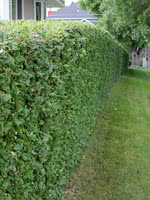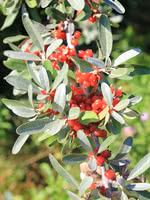Mon-Fri 9am - 5pm Mountain time
Peking Cotoneaster vs Silver Buffalo Berry
Cotoneaster acutifolia
Shepherdia argentea
NOT AVAILABLE THIS SEASON - MIGHT RETURN
Peking Cotoneaster is a medium-sized shrub that is well adapted to colder climates. Best suited for use as a hedge, Peking Cotoneaster has dark green foliage that turns a stunning reddish orange in the fall.
Hardy fruit guru, Bernie Nikolai (DBG Fruit Growers), has started to recommend grafting hardy pear varieties to Peking Cotoneaster after his experiences were successful and produced fruit faster than other rootstocks. Remember to leave some nurse limbs if you try this.
Silver Buffalo Berry is a cold hardy, ornamental shrub that is commonly used in the first row of shelterbelts instead of caragana or lilac. It features subtle yellow flowers, smooth grey bark, and red fruit. On occasion orange fruit is produced and rarely a yellow fruit. Please note: we regularly collect the rare yellow and orange fruit to use for our seed source.
Long-lived and slow growing, Silver Buffalo Berry is commonly found around sloughs, in coulees, and on light soils across the prairies, and grows best in full sun.
Buyers can enjoy increased bird life to their property, as this shrub acts as a habitat plant. It is also commonly planted for its ornamental and winter interest. It is native to parts of central and western North America.
This species is also known as one of the more salt-tolerant species for those with saline soils.
Note: this berry has mixed reviews when fresh, but makes a desirable jam or jelly with what is described as a clove and pear taste.
Peking Cotoneaster Quick Facts
Silver Buffalo Berry Quick Facts
In row spacing: 0.3 m (1.0 ft)
In row spacing: 0.9 - 1.2 m (3 - 4 ft)

